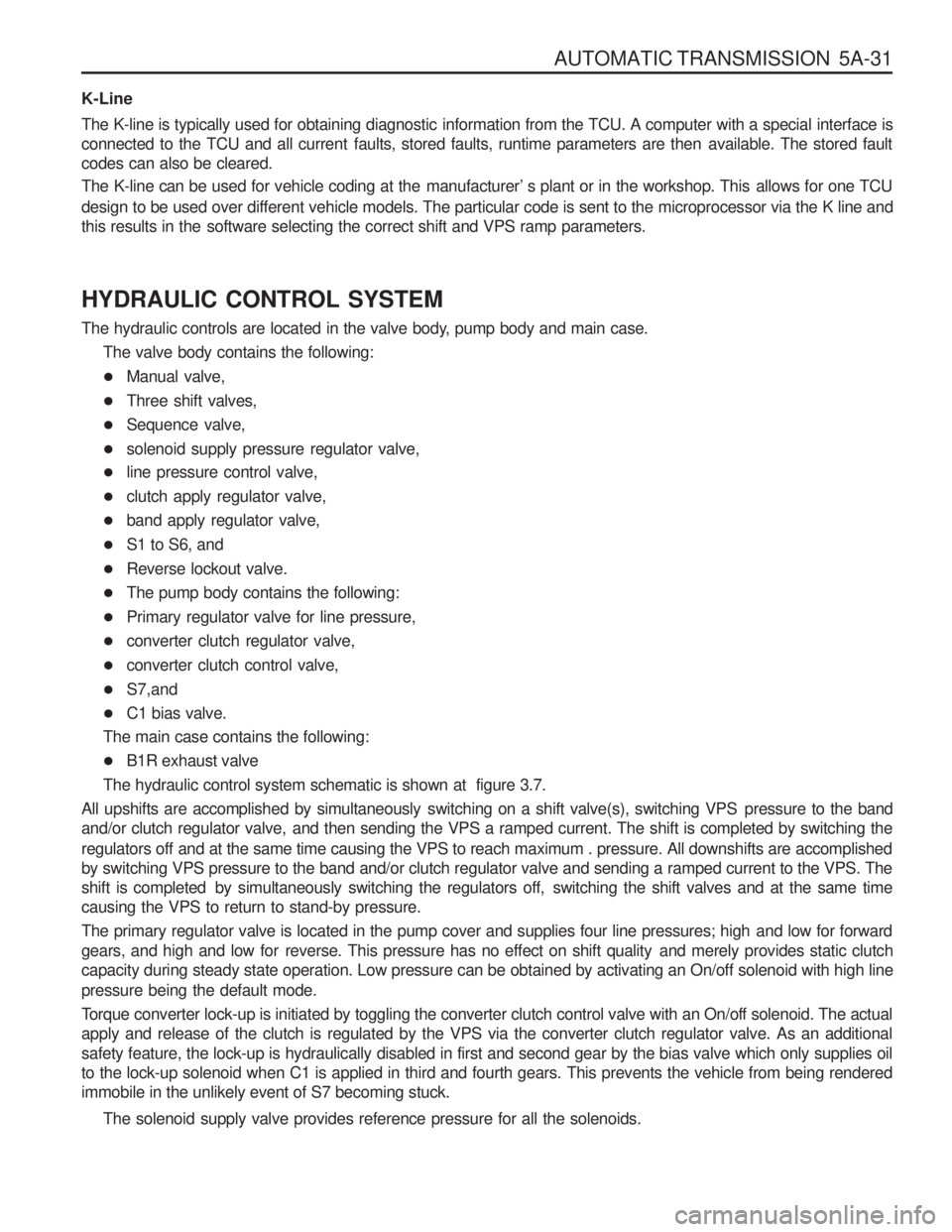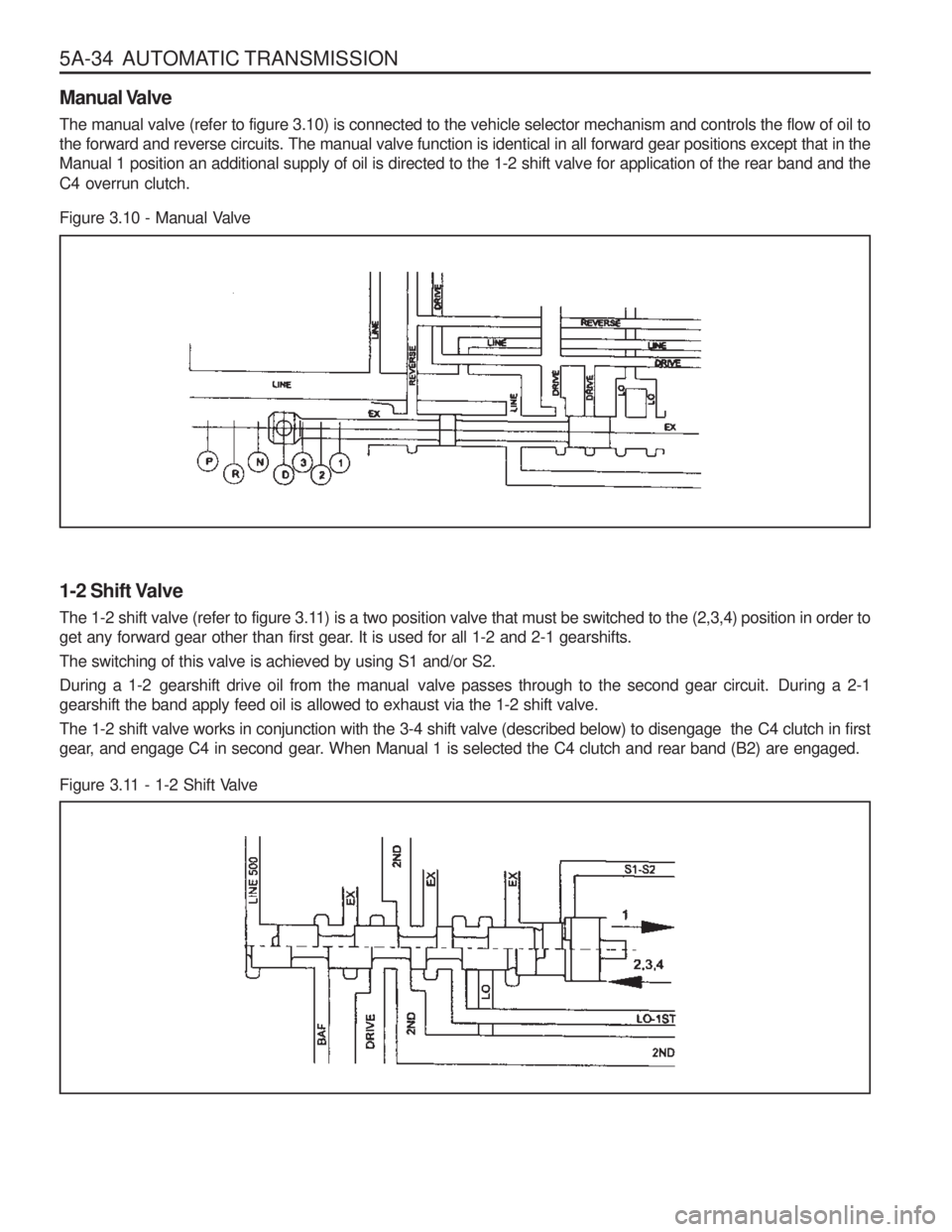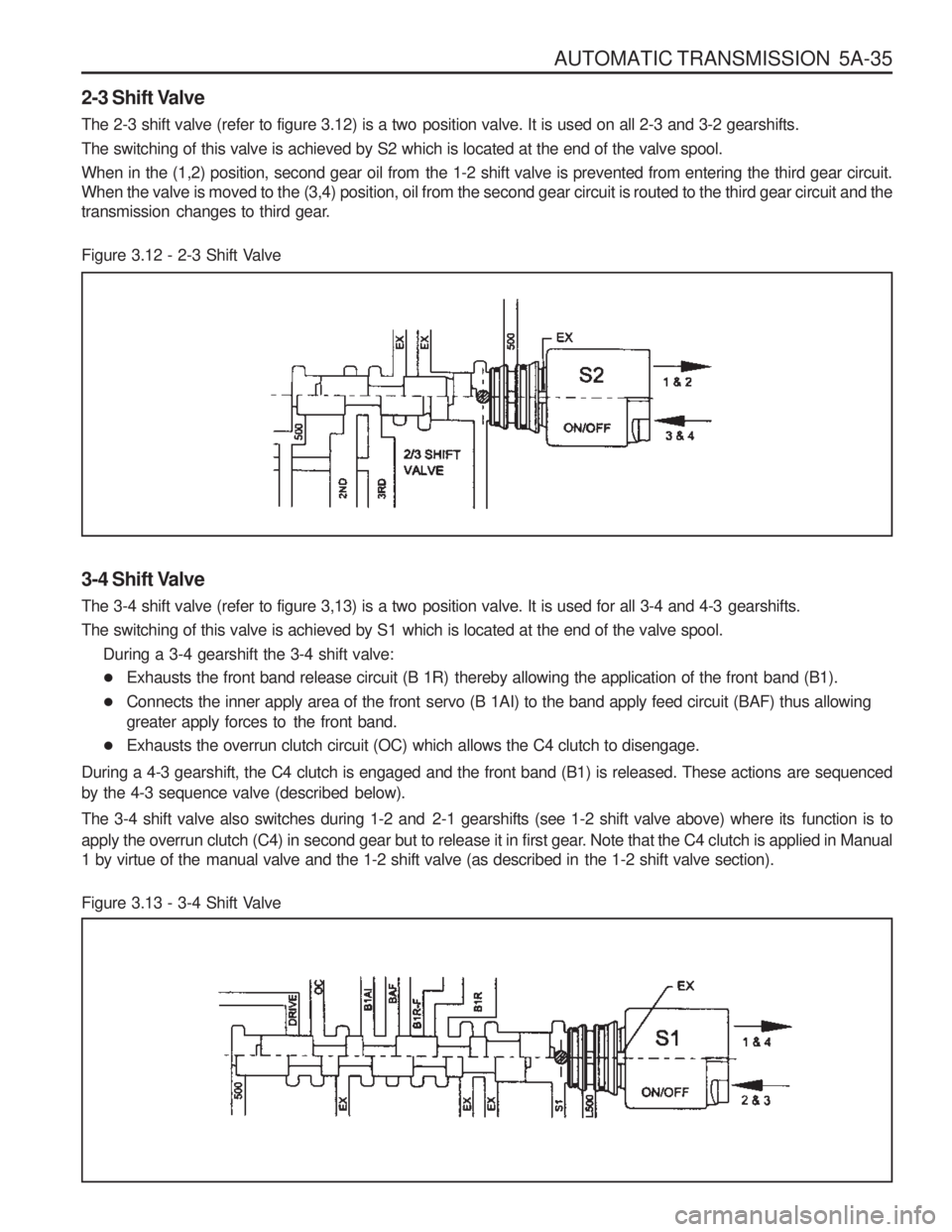2003 SSANGYONG MUSSO manual transmission
[x] Cancel search: manual transmissionPage 890 of 1574

AUTOMATIC TRANSMISSION 5A-31
K-Line
The K-line is typically used for obtaining diagnostic information from the TCU. A computer with a special interface is
connected to the TCU and all current faults, stored faults, runtime parameters are then available. The stored faultcodes can also be cleared.
The K-line can be used for vehicle coding at the manufacturer’ s plant or in the workshop. This allows for one TCU
design to be used over different vehicle models. The particular code is sent to the microprocessor via the K line and
this results in the software selecting the correct shift and VPS ramp parameters. HYDRAULIC CONTROL SYSTEM
The hydraulic controls are located in the valve body, pump body and main case.The valve body contains the following:
� Manual valve,
� Three shift valves,
� Sequence valve,
� solenoid supply pressure regulator valve,
� line pressure control valve,
� clutch apply regulator valve,
� band apply regulator valve,
� S1 to S6, and
� Reverse lockout valve.
� The pump body contains the following:
� Primary regulator valve for line pressure,
� converter clutch regulator valve,
� converter clutch control valve,
� S7,and
� C1 bias valve.
The main case contains the following:
� B1R exhaust valve
The hydraulic control system schematic is shown at figure 3.7.
All upshifts are accomplished by simultaneously switching on a shift valve(s), switching VPS pressure to the band
and/or clutch regulator valve, and then sending the VPS a ramped current. The shift is completed by switching the
regulators off and at the same time causing the VPS to reach maximum . pressure. All downshifts are accomplished
by switching VPS pressure to the band and/or clutch regulator valve and sending a ramped current to the VPS. The
shift is completed by simultaneously switching the regulators off, switching the shift valves and at the same timecausing the VPS to return to stand-by pressure.
The primary regulator valve is located in the pump cover and supplies four line pressures; high and low for forward
gears, and high and low for reverse. This pressure has no effect on shift quality and merely provides static clutch
capacity during steady state operation. Low pressure can be obtained by activating an On/off solenoid with high line pressure being the default mode.
Torque converter lock-up is initiated by toggling the converter clutch control valve with an On/off solenoid. The actual apply and release of the clutch is regulated by the VPS via the converter clutch regulator valve. As an additionalsafety feature, the lock-up is hydraulically disabled in first and second gear by the bias valve which only supplies oilto the lock-up solenoid when C1 is applied in third and fourth gears. This prevents the vehicle from being renderedimmobile in the unlikely event of S7 becoming stuck.
The solenoid supply valve provides reference pressure for all the solenoids.
Page 893 of 1574

5A-34 AUTOMATIC TRANSMISSION
Figure 3.10 - Manual Valve
1-2 Shift Valve
The 1-2 shift valve (refer to figure 3.11) is a two position valve that must be switched to the (2,3,4) position in order to
get any forward gear other than first gear. It is used for all 1-2 and 2-1 gearshifts.
The switching of this valve is achieved by using S1 and/or S2.
During a 1-2 gearshift drive oil from the manual valve passes through to the second gear circuit. During a 2-1
gearshift the band apply feed oil is allowed to exhaust via the 1-2 shift valve.
The 1-2 shift valve works in conjunction with the 3-4 shift valve (described below) to disengage the C4 clutch in first
gear, and engage C4 in second gear. When Manual 1 is selected the C4 clutch and rear band (B2) are engaged.
Figure 3.11 - 1-2 Shift Valve
Manual Valve The manual valve (refer to figure 3.10) is connected to the vehicle selector mechanism and controls the flow of oil to the forward and reverse circuits. The manual valve function is identical in all forward gear positions except that in theManual 1 position an additional supply of oil is directed to the 1-2 shift valve for application of the rear band and the C4 overrun clutch.
Page 894 of 1574

AUTOMATIC TRANSMISSION 5A-35
2-3 Shift Valve
The 2-3 shift valve (refer to figure 3.12) is a two position valve. It is used on all 2-3 and 3-2 gearshifts.
The switching of this valve is achieved by S2 which is located at the end of the valve spool.
When in the (1,2) position, second gear oil from the 1-2 shift valve is prevented from entering the third gear circuit.
When the valve is moved to the (3,4) position, oil from the second gear circuit is routed to the third gear circuit and the
transmission changes to third gear.
Figure 3.12 - 2-3 Shift Valve
3-4 Shift Valve
The 3-4 shift valve (refer to figure 3,13) is a two position valve. It is used for all 3-4 and 4-3 gearshifts.
The switching of this valve is achieved by S1 which is located at the end of the valve spool.During a 3-4 gearshift the 3-4 shift valve:
� Exhausts the front band release circuit (B 1R) thereby allowing the application of the front band (B1).
� Connects the inner apply area of the front servo (B 1AI) to the band apply feed circuit (BAF) thus allowing
greater apply forces to the front band.
� Exhausts the overrun clutch circuit (OC) which allows the C4 clutch to disengage.
During a 4-3 gearshift, the C4 clutch is engaged and the front band (B1) is released. These actions are sequenced
by the 4-3 sequence valve (described below).
The 3-4 shift valve also switches during 1-2 and 2-1 gearshifts (see 1-2 shift valve above) where its function is to
apply the overrun clutch (C4) in second gear but to release it in first gear. Note that the C4 clutch is applied in Manual
1 by virtue of the manual valve and the 1-2 shift valve (as described in the 1-2 shift valve section).
Figure 3.13 - 3-4 Shift Valve
Page 897 of 1574

5A-38 AUTOMATIC TRANSMISSION
Reverse Lockout Valve
The reverse lockout valve (refer figure 3.18) is a two position valve contained in the upper valve body. This valve
uses 51-52 pressure as a signal pressure and controls the application of the rear band (B2).
While the manual valve is in D,3,2, or 1 positions, drive oil is applied to the spring end of the valve, overriding any
signal pressures and holding the valve in the lockout position. This prevents the application of B2 in any of theforward driving gears.
When the manual valve is in P, R or N positions, drive oil is exhausted and the reverse lockout valve may be toggled by S1-S2 pressure.B2 is applied in P, R, and N provided that the following conditions are satisfied:
1. In P or N, roadspeed 3 km/h.
2. In R, road speed 10 km/h.
3. Engine speed 1400 rpm.
4. For diesel vehicles, throttle 25%.
5. For gasoline vehicles, throttle 12%.
Under these conditions, the TCU switches solenoids S1 and S2 to Off. The reverse lockout valve toggles under the
influence of the S1-S2 pressure, to connect the line pressure to the B2 feed. Oil is fed to both the inner and outer
apply areas of the rear servo piston, applying B2.
If any of the above conditions are not satisfied, the TCU switches solenoids S1 and S2 to On. S1- S2 pressure is
exhausted and the valve is held in the lockout position by the spring. In this position, engagement of B2 is prohibited.
This feature protects the transmission from abuse by preventing the undesirable application of B2 at high speed, and
by providing a reverse lockout function.
Note that if the transmission is in failure mode, the rear band will be applied at all times in P, R and N.
Figure 3.18 - Reverse Lockout Valve <
<
<
<
<
Page 901 of 1574

5A-42 AUTOMATIC TRANSMISSIONPOWER TRAIN SYSTEM
The Power Train System consists of: � A torque converter with single face lock-up clutch
� Four multi-plate clutch assemblies
� Two brake bands
� Two one-way clutches
� Planetary gearset
� Parking mechanism
A conventional six pinion Ravigneaux compound planetary gearset is used with overdrive (fourth gear) being obtained
by driving the carrier.
The cross-sectional arrangement is very modular in nature. Four main sub-assemblies are installed within the case
to complete the build. These sub-assemblies are: � Gearset-sprag-centre support
� C1 -C2-C3-C4 clutch sub-assembly
� Pump assembly
� Valve body assembly
One, or a combination of selective washers are used between the input shaft flange and the number 4 bearing to
control the transmission end float. This arrangement allows for extensive subassembly testing and simplistic finalassembly during production.
A general description of the operation of the Power Train System is detailed below. Refer to table 4.1 and figure 4.1.
First gear is engaged by applying the C2 clutch and locking the 1-2 One Way Clutch (1-2 OWC). The 1-2 shift is
accomplished by applying the B1 band and overrunning the 1-2 OWC. The 2-3 shift is accomplished by applying the
C1 clutch and releasing the B1 band. The 3-4 shift is accomplished by re-applying the B1 band and overrunning the
3-4 OWC. Reverse gear is engaged by applying the C3 clutch and the B2 band.
The C4 clutch is applied in the Manual 1,2 and 3 ranges to provide engine braking. In addition, the C4 clutch is also
applied in the Drive range for second and third gears to eliminate objectionable freewheel coasting. The B2 band is
also applied in the Manual 1 range to accomplish the low-overrun shift.
Both the front and rear servos are dual area designs to allow accurate friction element matching without the need for
secondary regulator valves. All the friction elements have been designed to provide low shift energies and high static
capacities when used with the new low static co-efficient transmission fluids. Non-asbestos friction materials are used throughout.
Gear
First
Second ThirdFourth
Reverse
Manual 1 Gear
Ratio 2.741 1.508 1.0000.7082.4282.741 C1
XX C2
X X XX X C3
X C4
X X B1
X X X B2
X X 1-2
OWC X 3-4
OWC X XX LU
CLUTCH
X*X
ELEMENTS ENGAGED
* For Certain Vehicle Applications, Refer to the Owner's Manual.
Table 4.1 - Engaged Elements vs Gear Ratios
Page 903 of 1574

5A-44 AUTOMATIC TRANSMISSION CLUTCH PACKS
There are four clutch packs (refer to figure 4.3). All clutch packs are composed of multiple steel and friction plates. C1 CLUTCHWhen applied, this clutch pack allows the input shaft to drive the planet carrier.
This occurs in third and fourth gears.C2 CLUTCH When applied this clutch pack allows the input shaft to drive the forward sun gear via the 3-4 OWC.
This occurs in all forward gears.C3 CLUTCH When applied this clutch pack allows the input shaft to drive the reverse sun gear. This only occurs in
reverse gear.C4 CLUTCH When applied this clutch provides engine braking on overrun. This occurs in Manual 1, 2 and 3 and
also Drive 2 and Drive 3 to prevent objectionable free wheel coasting.
Figure 4.3 - Clutch Packs
Page 904 of 1574

AUTOMATIC TRANSMISSION 5A-45
BANDS
The transmission utilises two bands, the B1 band (sometimes known as the 24 band), and the B2 band (sometimes
known as the low-reverse band). Refer to figure 4.4.
The B1 band is a flexible band which is engaged by the front servo piston. B1 is activated in second and fourth gear.
When activated B1 prevents the reverse sun gear from rotating by holding the C3 clutch assembly stationary. In
second gear only the outer area of the apply piston is utilised. In fourth gear both areas are utilised for greater clamping force.
The B2 band is a solid band which is engaged by the rear servo piston. B2 is activated in Park,
Reverse, Neutral and Manual 1. When activated B2 prevents the planet carrier assembly from rotating. In Manual 1
only the inner area of the apply piston is utilised. In Park, Reverse and Neutral, both areas are utilised for greater clamping force. Figure 4.4- Bands
ONE WAY CLUTCHES
The transmission uses two OWCs, the 1-2 OWC and the 34 OWC. (Note that a third OWC is located in the torque
converter, also known as a sprag.)
The 1-2 OWC is located between the planetary carrier assembly and the centre support. This allows the carrier to
rotate around the centre support in one direction only. The one way clutch is engaged only in Drive 1.
The 3-4 OWC is located between the C4 and the C2 clutch assemblies. This allows the C2 clutch to drive the forward
sun gear in first, second and third gears but unlocks in fourth gear and during overrun.
PLANETARY GEAR SET
The planetary gear set used in the transmission is a conventional six pinion Ravigneaux compound gear set.
Page 905 of 1574

5A-46 AUTOMATIC TRANSMISSION PARKING MECHANISM
When Park is selected the manual lever extends the park rod rearwards to engage the parking pawl (refer to (figure
4.5). The pawl will engage the external teeth on the ring gear thus locking the output shaft to the transmission case.
When Park is not selected a return spring holds the parking pawl clear of the output shaft, preventing accidental engagement of Park.
Figure 4.5 - Park Rod and Cross Shaft